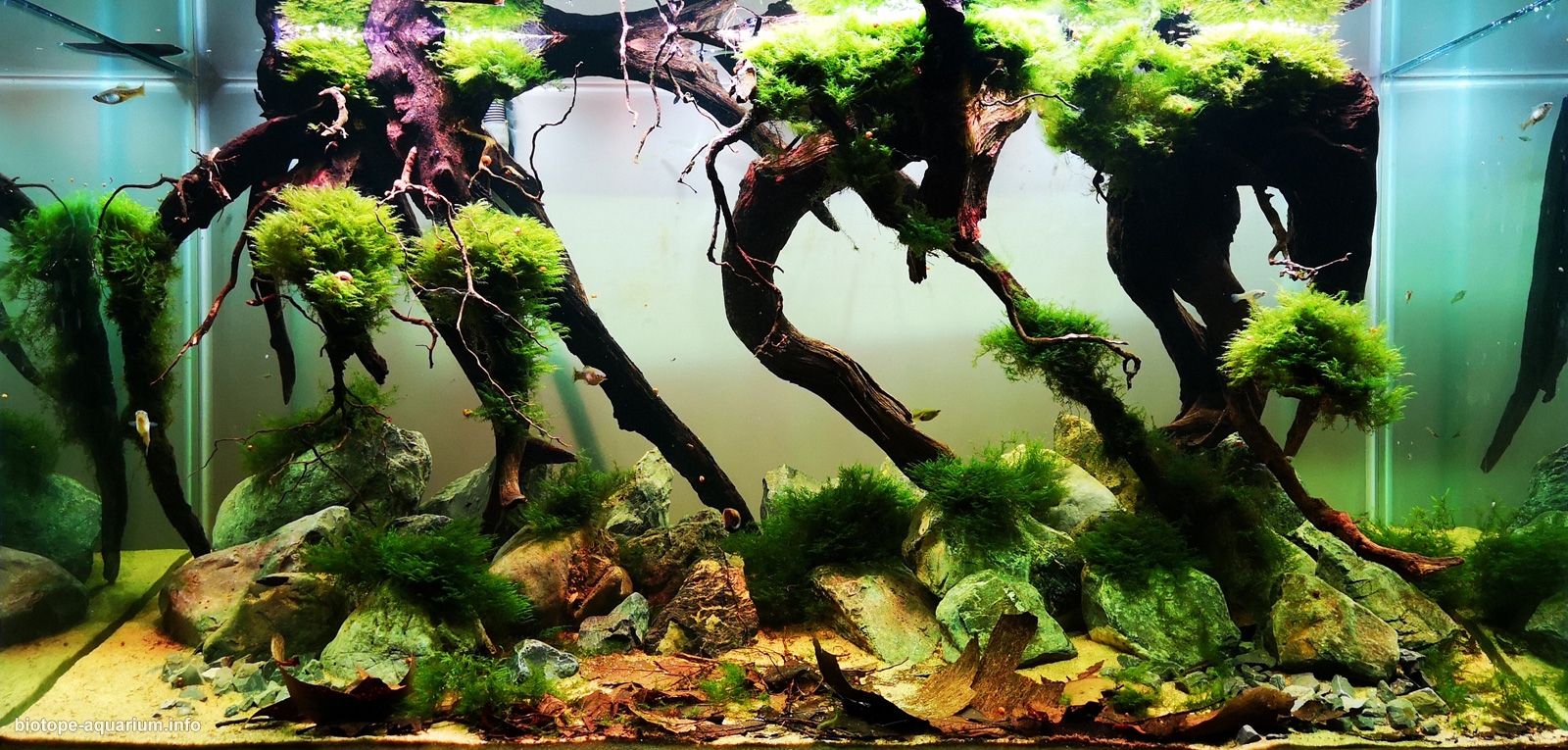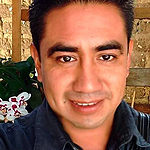Santa Ana, Nuevo León, Mexico
57th place in Biotope Aquarium Design Contest 2018
![]() Mexico. Marco Antonio Arroyo Torres
Mexico. Marco Antonio Arroyo Torres

Volume: 366 L
Dimensions: 122x50x60 cm
List of fishes: Xiphophorus sp. “regio”, Gammarus sp. The work iam presenting now, consist in the habitat of a fish from the family Pociliidae and the genus Xiphophorus, they are a freshwater fish, the genus comprised of 26 species. These fishes live in drainages in eastern Mexico, Guatemala, Belize and Honduras, with most of the described species living in Mexico. The taxa make up three groups: the Northern Swordtails, the Southern Swordtails, and the Platyfish, according to the Xiphophorus Genetic Stock Center, who has operated within the United States since the 1930’s making it one of the oldest live animal resource centers worldwide. In 1992, due to the retirement of its past director Dr. Klaus Kallman, the XGSC moved to Texas State University; now the fish from the habitat or biotope im working on, is a species undescribe, and its located very near from one of the main cities in México, these species is still under investigation by the conservation biologist Arcadio Valdés González, Phd of Nuevo León State University, well, these fish was recently discover near from the city of Monterrey, in an isolated forest at the headwaters of the local Santa Ana creeek in southeast Monterrey, wich discharges into the Arroyo Ebanal, a stream of the Santa Catarina river, González has proposed the species name “regio”. So the habitants of the aquarium consist in 30 plus, Xiphophorus sp “regio”, and some Gammarus sp. that lives in the mosses (Fissidens fontanus).
List of plants: Fissidens fontanus
Description of decorations: I used roots equal to the area where the habitat of Xiphophorus sp. Regio, in the town of Santa Ana, Nuevo León, as well as the rocks that made up the hardscape are distributed along the river of the same habitat and can be seen in the videos of the links that are attached, the aquarium have almost 40 kilograms of silic sand, it can also be observed the use of dry leaves which correspond to two trees that are present in the area and that cover the pond wich are the Platanus occidentalis and the Forestiera pubescens.
Description of equipment: Canister filter fluval 305, multi-stage filtration for aquariums up to 300 Liters (70 U.S. gallons), and two led lamps of high quality of the brand Messi lamps, made in México of 52 watts and 4400 lumens.
Water parameters: Temperature 25ºC, ph 7.2, kh 180 ppm, chlorine 0 mg/l, Gh 300 ppm, Nitrite NO2 .5 Mg/l, Nitrate NO3 10 Mg/l.
INFORMATION ABOUT BIOTOPE
Description of the area surrounding the biotope: Nuevo León is a state of Mexico whose capital is Monterrey, the hydrography of this state is very varied because it is composed of rivers, lakes, lagoons and dams. Each of them has its own characteristics. The place where the biotipe or habitat of the fish Xiphophorus sp “regio” its a chain of mountains well known as cerro de la silla, and its compose of a mountain range of a lot of kilometers, the place its located at 24 kilometers away from dowtown, very near considering that its a new species, the area around the habitat is surrounded by a large amount of flora and fauna, since the place is not very busy, the habitat consists of a small stream that comes down from the mountain, and in the banks of this stream we can find plants like Adiantum tricholepis, Callitriche stagnalis, Eleocharis sp., Plantago major, Shelf fungi, Begonia uniflora, Ferns Thelypteris, Xanthosoma robostum, Lobelia cardinalis, among others; being important point to highlight the large number of butterflies that can be seen in the area such as, Battus philenor, Anthanassa texana, Euptoieta hegesia, Phoebis agarithe, Chlosyne lacinia, Heterusia atalantata and many more.
Description of the underwater landscape of the biotope: The aquatic landscape consists of a stream of water flowing almost all the time, except for some small isolated ponds, places where the Xiphophorus could not be found because they prefer to live in places with constant movement of water, the bottom in some parts, mainly near the banks consists of silic sand and some rock known as Reynosa, of a very small caliber, and in the deepest parts we can find rocks with capricious forms and calcareous, there is absence of aquatic plants, we only find some marginal ones with the exception of the moss Fissidens fontanus and Ludwigia repens.
Description of the parameters of the habitat: The driest month is December, with 15 mm of rain. With an average of 145 mm, the highest precipitation falls in September. July is the warmest month of the year, the temperature in July averages 28.2 ° C. January has the lowest average temperature of the year. It is 14.0 ° C, The water stays allways trasnparent or clear, because its flowing all the time, and this are the parameters of the river, ph 7.8, kh 300ppm, chlorine 0 Mg/l, Gh 300 ppm, Nitrite NO2 0 Mg/l, Nitrate NO3 20 Mg/l.
List of fishes and invertebrates occurring in the nature biotope: The list of fauna its complex, mainly because of the introduction of some fishes and invertebrates, you can find as a native fauna the Xiphophorus sp. Regio, Herichthys cyanogutattus, Dionda sp., Astyanax mexicanus, Gammarus sp., and introduce Oreochromis niloticus, Procambarus clarkii, Heterandria bimaculata.
List of plants found in the nature biotope: Theres a lot of plants you can find in the banks of the river, the majority are lacustrine, the aquatics ones are the moss Fissidens fontanus, Ludwigia repens, and lacustrine theres Lobelia cardinalis, Eleocharis sp., Polygonum lapathifolium, and some Colocasia sp., and ferns such as Tactaria heracleifolia, Polypodium polipodioides, Adiantum capillus-veneris.
Threats to the ecology: The porpouse of making the biotipe of Santa Ana in an aquarium, is first of all, let know the people that exist a new species of platy near from our city and that stays undiscribe, that we need to protect the enviroment where this fish lives and take the responsability of keep safe and free of pollution the river where it lives, most of the citizens doesn care about fishes, cause they dont look charismatic, they prefer to protect animals that can touch or see such as big mammals, by donating money to ONGS or by themselves, but the true and sad thing is that the most precious treasure we have in our planet is the water, and if the fishes or invertabrates that live in there stay in bad conditions or shape, then that means that the water is not suitable to hold the population of organism because its polluted or something else, and we depend of freshwater to survive, so what we need to teach to the people is if they protect the fishes and its habitat, then the water will be safe and ergo we can ensure at least some time of survival.
The threats presented in the habitat have been and continue to be latent, some years ago there was a plan to create a tunnel that would cross precisely through the Santa Ana canyon, which in the end caused the imminent deterioration of the small body of water, fortunately Through the support of some biologists interested mainly in flora and birds, the project was halted, however, theres currently a number of invasive species that compete directly with the Xiphophorus and that put their permanence at risk because they are not in abundant way. Also theres a risk to lose the species for the introduction of some other species of Xiphophorus that will end with hybridization, in the same river but downstream you can find lots of platys in differents color , that mean that somebody introduce maybe some Xiphophoru variatus that hybridaze with sp “regio”.
Sources of information:
– Freshwater fishes from México, Robert Rush Miller, The University of Chicago Press
– www.xiphophorus.org, Xiphophorus Genetic Stock Center
• In this video you can watch the pond in rainy seasson:
• In this video you can watch the pond in dry seasson:
Videoblog exploring the habitat by myself
• In this video you can watch the pond in rainy seasson:
• In this video you can watch the pond in dry seasson:
Comments of the members of the jury of Biotope Aquarium Design Contest 2018

An aquarium that shows very well a part of the nature biotope, using elements of the recreated area, which can be checked with the support material. As a recommendation I would cover the bottom of the aquarium with more roots to achieve an even more realistic impression of water body margin. In general it is a good work!

This is interesting. My first thought: this does not look natural at all. After all it is a good try to show the combination of the root system and the mosses, but this tank will look way better when mosses will grow and algae will appear. An interesting other interpretation of this river system in the aquarium could be based on the shot in your first video around 32 seconds.
